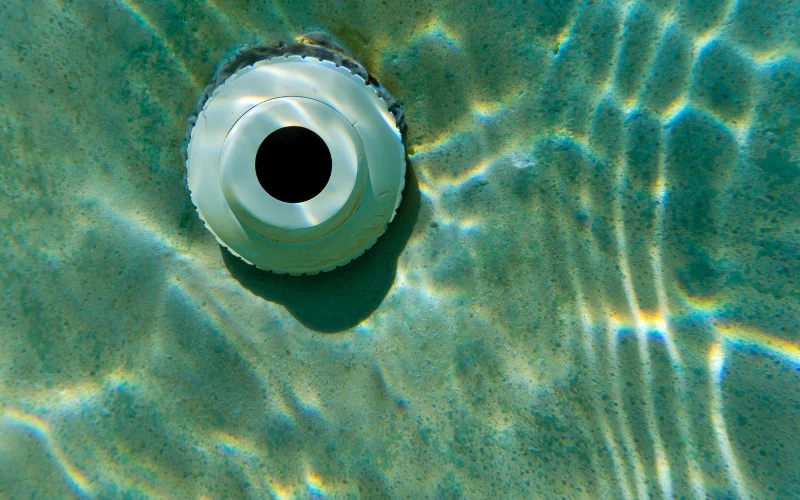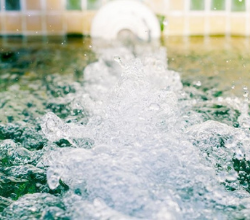
Treating swimming pool stains doesn’t have to be a major problem if you deal with them as soon as they are identified. It’s like spilling a glass of red wine on the carpet. If you treat the carpet straight away the stain will be easier to remove. If you leave the red wine stain on the carpet for a couple of months, it’s going to take a lot more effort to remove and potentially you may need to replace the carpet!
Treating swimming pool stains
So, when dealing with staining on your pool the first place to start is to identify the type of stain.
Swimming pool stains generally fall into two categories:
- Metal or rust-based: Metals can accidentally be introduced into pools from well water or corrosion from copper pipes or as an impurity from salt.
- Organic: Leaves, berries, and other organic debris can also leave stains if allowed to settle on pool surfaces.
Start by looking at the colour of the stain. Different causes create different colour stains and can be good indicators of exactly what has caused the stain.
Green and Brown Stains: Organic matter such as leaves, or other plant matter are commonly the reason for this colour staining.
Red and Blue Stains: These stains are more than likely from brightly coloured berries; check the area around the pool for the offending bush (and then get your chainsaw out!).
Blue, Green and Black Stains: When a stain is a mixture of dark blue, green and black and there is no evidence of organic matter, it is likely to have been caused by copper.
Green, Brown, and Red Stains: This combination indicates iron as the culprit.
Brown, Black, and Purple Stains: This dark colour combination is usually caused by manganese.

Now that you’ve identified the likely cause of the staining it’s time to do a small test on an area of staining to see if you are correct.
For suspected organic staining, test by applying a small amount of chlorine directly onto the stain. You can do this by sprinkling some granules (Power Chlor or Swim Clear) onto the stain or by putting some granules in an old sock and then rubbing it on the stain. Take care if you have a bleachable surface (such as a vinyl liner) as this could causing bleaching. If the stain is organic the chlorine should lift or bleach the stain away.
If you suspect a metal is the cause of the staining, test this by applying a small amount of acid (Lo’n’Slo) onto the stain. If the stain lifts or lightens then it is a metal stain.
Treatment of organic pool stains
Super chlorination (high chlorine level in the water) is the answer to treating organic staining, followed by a good brushing of the stain/s.
Begin by testing the water and checking the pH and alkalinity. pH should be between 7.4 and 7.6, and alkalinity should be between 100 and 150 ppm (parts per million) depending on your pool surface. If you are unsure of the correct levels for your pool or aren’t confident with your testing, bring in a pool water sample for a free test. Adjust the levels if necessary.
For multiple or large stains, the water should be heavily shocked. If you have a salt chlorinator or use liquid chlorine, you can use granular chlorine (Burnout Extreme, Power Chlor) to super chlorinate. Pools that are routinely dosed with dichlor (Swim Clear) or trichlor (Pacific Blue Power Tabs or Power Chlor) products should use liquid chlorine to super chlorinate to avoid excessive levels of stabiliser (cyanuric acid). If using liquid chlorine add to the pool in the evening.

Keep your filter system running for at least 8 hours. Once it’s been shocked, thoroughly brush all the stains, then let the pool water circulate for at least another eight hours. Continue to brush the stains intermittently and keep the chlorine level high until the stains are finally gone.
Treatment of metal stains
Metal stains may require professional intervention. The first step is to bring a water sample into our store for testing and some photos of the stains. Depending on the type of stain it may or may not be detectable in the water. Once the causative metal is identified we can recommend the appropriate treatment to remove the stain. No two stains are the same, so we tailor each solution to the stain being treated.
Add the chemicals according to the instructions, brushing the stain to help the process along. If the additives and brushing don’t do the trick, you may have to empty the pool for treatment of the stains.
We recommend the BioGuard range of specialty products for dealing with metal stains. They have a complete range of products to treat metal stains including Pool MagnetPlus, Metal Go, Quick-Clear and Filter Brite.

Future pool stain prevention
It’s not difficult to prevent staining and it’s just as important as any other facet of pool maintenance. By maintaining the correct level of sanitiser (chlorine) in your pool at all times and ensuring your pH and alkalinity are in balance, the chances of staining are kept to a minimum.
Organic matter that is in contact with the pool surface for extended periods of time will cause staining. Keep your pool clean by regularly vacuuming (manually or with an automatic pool cleaner) and skimming the surface of the water.
The best preventative measure against metal stains is to test your pool water regularly for the presence of metals and address it before stains form. If your pool is prone to metal contamination due to well water or other factors, be sure to use Pool Magnet Plus as part of your regular pool maintenance. This product sequesters minerals in solution, which prevents them from binding to pool surfaces.
In the case of a copper problem, it’s worth noting that low pH can also cause a recurrence of stains. Low pH indicates acidic water, which corrodes copper and introduces it into your pool. Always keep your pH level between 7.4 and 7.6 (unless your pool builder has specified a different level).
If you need any further help on treating swimming pool stains or need a professional clean, don’t hesitate to get in touch. We’d love to help.

























